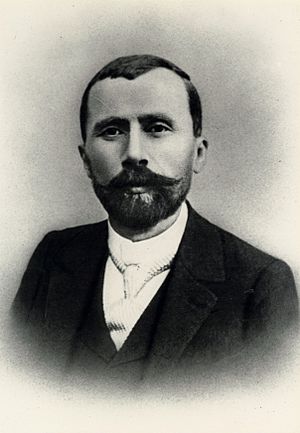Léon Teisserenc de Bort facts for kids
Quick facts for kids
Léon Teisserenc de Bort
|
|
|---|---|

Léon Teisserenc de Bort
|
|
| Born | 5 November 1855 |
| Died | 2 January 1913 (aged 57) |
| Nationality | French |
| Known for | stratosphere |
| Awards | Symons Gold Medal (1908) |
| Scientific career | |
| Fields | Meteorology |
Léon Teisserenc de Bort (born November 5, 1855, died January 2, 1913) was a French scientist. He studied the atmosphere and was a pioneer in a field called aerology. This is the study of the upper air.
Léon Teisserenc de Bort is famous for discovering the stratosphere. He announced this discovery around the same time as another scientist, Richard Assmann, in 1902. Teisserenc de Bort was also one of the first to use special balloons. These balloons carried instruments high into the sky. He used them to find a special part of the atmosphere. This area is about 8 to 17 kilometers (5 to 11 miles) high. Today, we call this area the tropopause.
Contents
Early Life and Work
Léon Teisserenc de Bort was born in Paris, France. His father was an engineer. Léon started his science career in 1880. He joined the weather department in Paris. This was part of the French government.
From 1883 to 1887, he traveled to North Africa. He studied geology and Earth's magnetism there. He also made important maps. These maps showed air pressure high in the atmosphere. Between 1892 and 1896, he was the main weather scientist for the Bureau.
Pioneering Weather Balloons
After leaving his job in 1896, he opened his own weather observatory. This was in Trappes, near Versailles. There, he studied clouds and the upper parts of the air. He did many experiments with high-flying balloons. These balloons were filled with hydrogen gas. They carried scientific tools. He was one of the first to use such devices.
In 1898, Teisserenc de Bort shared his findings. He wrote about his balloon research. He noticed something interesting about air temperature. The temperature dropped steadily up to about 11 kilometers (7 miles) high. But above that height, the temperature stayed the same. It did not get colder.
This meant he found a layer where the temperature stopped falling. For a long time, he was not sure if this was real. He worried his tools might be giving wrong readings. This was because the sun could heat the instruments. So, he did over 200 more balloon flights. Many of these were at night. This helped avoid the sun's heat. By 1902, he was sure. He suggested that the atmosphere had two main layers.
Discovering the Troposphere and Stratosphere
In the years that followed, he gave names to these two layers. He called the lower layer the "troposphere". He named the upper layer the "stratosphere". These names are still used today. Other layers discovered later also follow this naming style.
After Teisserenc de Bort passed away in 1913, his family gave his observatory to the state. This allowed his important research to continue.
Other Important Studies
Léon Teisserenc de Bort also did studies in other places. He worked near Viborg in Denmark (1902-1903). He also studied the air in Sweden and over the Zuider Zee (a former bay in the Netherlands). He even studied the Mediterranean Sea and the tropical Atlantic Ocean. He used a special ship to study air currents above the trade winds.
He became a member of the Royal Meteorological Society in 1903. In 1909, he became an honorary member. He also won the Symons Gold Medal from the Society in 1908. He worked with Hugo Hildebrandsson on a book about weather science in 1907.
Named After Him
See also
 In Spanish: Léon Teisserenc de Bort para niños
In Spanish: Léon Teisserenc de Bort para niños
- Timeline of hydrogen technologies

